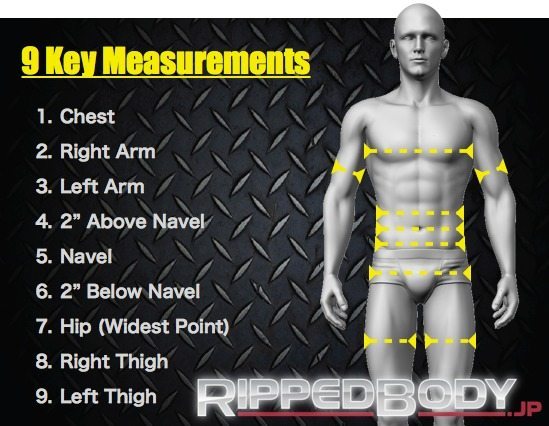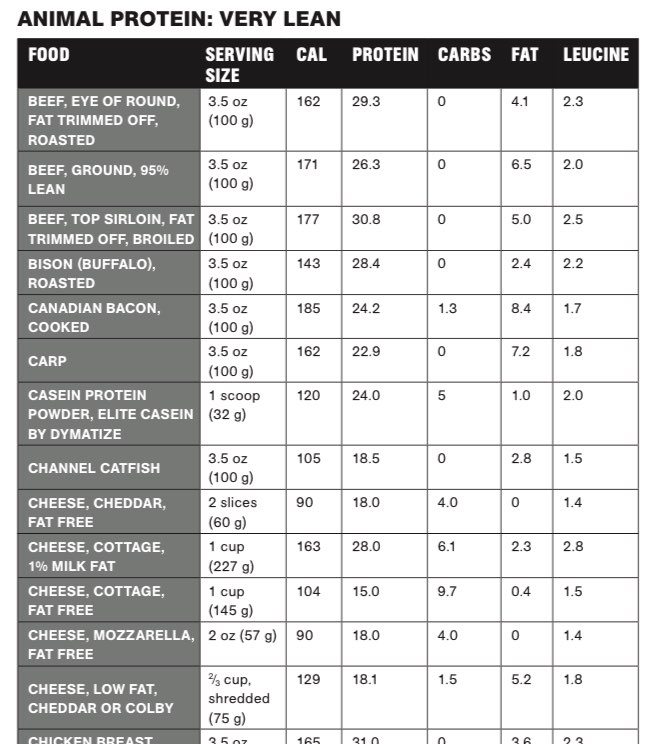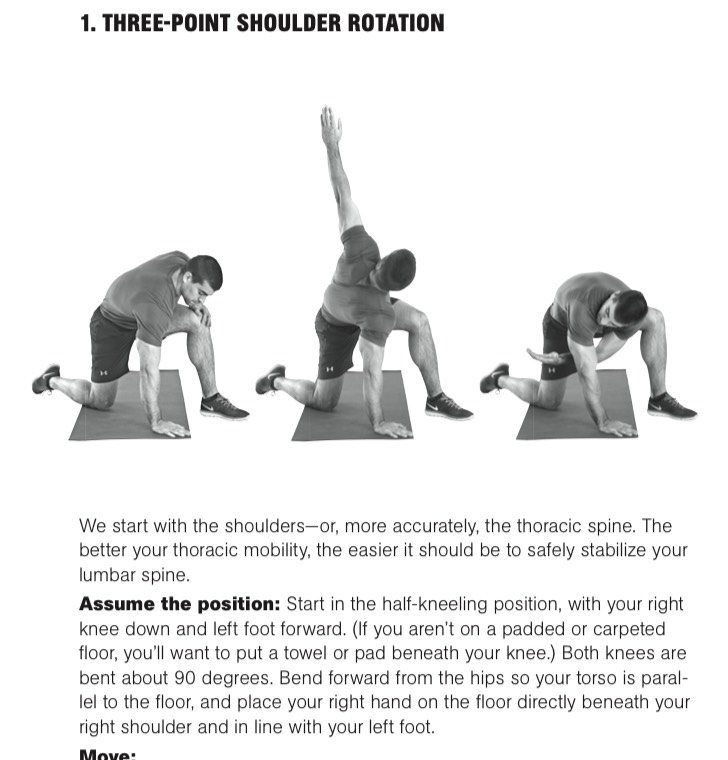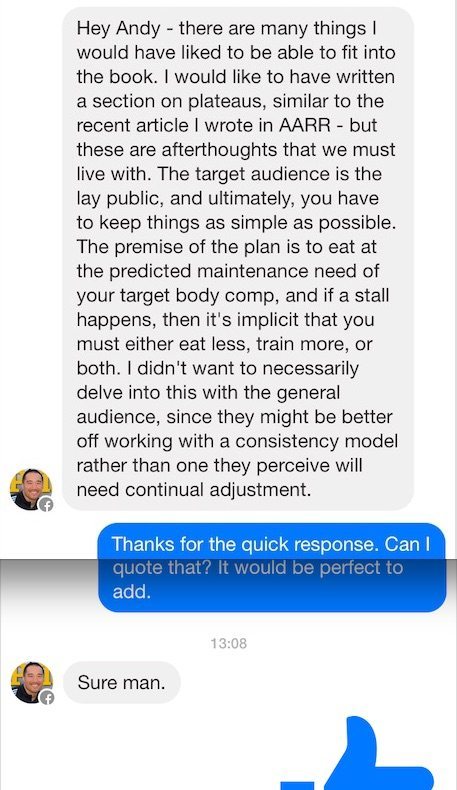Lou Schuler is an award-winning fitness journalist and author. Alan Aragon is one of the world’s most influential figures in the modern movement towards evidence-based sports nutrition. They have the best part of 50 years of experience on the right side of this industry between them, and this is their first book collaboration.
Knowing the work of both of these gentleman, it was a foregone conclusion that this book was going to be good, and it doesn’t disappoint. Despite high expectations, it has still managed to pleasantly surprise me in multiple places, and I feel it falls short in only one. This is an excellent book, and I’d go as far as to say it’s probably the best book on dieting that I think has hit mainstream bookstore shelves in… well, ever really.
Ready? Let’s get into the details then.
What is ‘The Lean Muscle Diet’?
It is a book providing an easy to understand breakdown of what the science currently says is likely to be optimal for chasing your physique goals and a guide on how to implement that. Despite the name, over half the book is dedicated to training.
The priorities of the diet are as follows:
- Hitting your target for total calories
- Hitting your macronutrient targets, especially for protein
- Getting almost all your food from whole and minimally processed sources
No surprises then.
There’s also the highly sensible & realistic suggestion that 10% of your calories for the week can be allotted to what most people consider junk foods – which I think Alan defined as highly processed stuff that would survive a nuclear war.
Who is ‘The Lean Muscle Diet’ not for?
- It’s not for those looking for a simple fad diet – I’ve mentioned on the site before that it seems some people simply have to go away and fail a few times before they are willing to listen to a voice talking about the (devastatingly effective) ‘middle ground’ and moderation.
- This is a diet book for the mainstream. It’s not for those looking for the super geeky, nitty gritty details on nutrition. For that, you want to be checking out Alan Aragon’s Research Review, or Lyle McDonald’s BodyRecomposition.com. I’ve read every corner of both, and while they are brilliant, they aren’t suited for most people.
- It’s not for those looking for detailed discussion and explanation of training periodization theory and implementation – i.e. what to do when you stop getting gains from your workouts. In fairness, this can get very complicated, very quickly, and to attempt this in the same book would only add layers of unnecessary complication into the mix for most readers. I’d guess this was a purposeful omission.
Who is ‘The Lean Muscle Diet’ for?
- This is for anyone that has been strung out, unsuccessful and frustrated with their lack results from their diet efforts so far. It is especially relevant for anyone that has been caught in the fad diet bandwagon.
- There is a good deal of not so common, common sense discussed and explained in layman terms that the vast majority of people will enjoy.
- I can see it being useful for someone perhaps subscribed to Alan Aragon’s monthly Research Review, who perhaps enjoys the study analysis but has been struggling to put it all the information together.
- The information in the book is equally applicable to men and women, but it’s written in a way that will reverberate more with male readers. Personally, I think this was a smart move – serious female trainees won’t care and will love it anyway, and it leaves Lou and Alan the opportunity to make a small fortune next year, by putting some butterflies in the corner of each page, and rebranding the book as “The Slender Look Diet“.
There is a quick history of diets and dieting. A bit of myth busting. Practical guidelines on calculating required energy intake, macros, and specific foods to eat to fit that. There are useful summary action points at the end of each section, and example diet set-ups for four separate men that I think works particularly well in showing people how to implement things for themselves.
Now that we’ve got that summary out of the way I’d like to discuss some of the dirtier details that I know regular readers of this site will probably want to know.
The Diet Section
Calorie and Macro Calculations
Alan describes a more simplified way of calculating calorie requirements than I have seen him do before, based on bodyweight targets. I like it, as the math is simpler and people are less likely to get it wrong.
Macro calculations from there are done in a similar method to what you see on the site. As they were based on his work reviewing the scientific literature anyway, that it no surprise.
Carb cycling is discussed as an option but stops short of going the full hog and discussing fat cycling too. That’s probably a good thing in honesty as too many people would get confused.
This still assumes that people can make a reasonable guestimation of getting their body fat percentage. Alan points out that BIA machines in your gym are to be avoided, and that calipers will likely give dodgy/inconsistent results. DEXA and BodPod are mentioned as unrealistic (but more accurate) methods, but I would have liked him to have pointed out that these aren’t very reliable or consistent either, just to stem the increasing number of people from going out and attempting to get these tests done periodically at great and unnecessary expense. Alan suggests using an online calculator where you measure your wrist, ankle, and other girths to get a ballpark figure for body fat percentage. Do I think this is good enough? For most people to begin with, yes.
Which brings me to my one and only criticism of an otherwise excellent book – I feel there should have been a section on how to track progress and then make adjustments to calorie and macro intake when progress stops or slows down. (I’ll come back to this at the end of this review, and include some of my own guidelines.)
Meal Plans
To those that aren’t used to counting their calories or macros, you need to be disciplined initially so that you get an idea of what is in your foods. That’s 2-3 weeks of pain before you get used to it and can relax.
I really like the food charts included, with their calorie, macro, and fiber amounts listed and categorized, and I think it strikes a good balance between being complicated enough, without being overwhelming. Also, because it’s not possible to list every single thing in there, it teaches people quickly that “close enough” is perfectly fine. Trying to get everything to the last gram isn’t a realistic or a healthy attitude – an important concept that Alan emphasizes.
When you give people an online calculator and say, “ok count your foods” certain personality types get so wrapped up in getting everything exact, that when they can’t find the foods they want to eat in there, instead of looking at the macros in a similar food, they quit eating it entirely. I think it can be quite stressful for some people to try and find everything exactly in an online calculator, and these charts look like a good balance to me.
I like that the leucine amounts are listed for the protein sources for both meat eaters, and for the vegetarian options, as this could turn out to be very important for vegetarians depending on what future studies into ‘leucine threshold theory’ turn out.
Meal frequency, nutrient timing, supplements, and alcohol are all topics that are addressed.
One of the excellent food charts included in the book.
The Training Section
The level of attention to detail in the training section was a pleasant surprise. Approximately half of the 300-page book is devoted to it. The warm-up guide is excellent. Their suggested program, a mix between classic bodybuilding and strength work, is solid. Readers of RippedBody.com will see that I have a strength bias in my training guides, so the number of exercises used in the program recommended in the book is more than I generally do, but I don’t disagree with any of it. It looks interesting. Interest drives motivation to get the work done with the required intensity to force adaptation and is an essential part of any program. So, if you think you prefer this over the more raw, strength based routines on the site – do it, give it your all, stick to it and you’ll do well.
As I’ve said before, there are multiple ways of coming to the same result, different doesn’t mean better or worse, it’s just different.
I’ll quote Lou here, “Just remember that the goal of training is to make adaptations, and a workout is only as good as the adaptations it produces, while it’s producing them.” He estimated the program will take around 14 weeks for an experienced lifter but will produce gains for longer in those with less training experience.
I’ll point out that as good as this section is, this is not the book to buy if you’re looking for a guide specifically on the barbell lifts. For that you need something more dedicated like Mark Rippetoe’s ‘Starting Strength.‘ – Rip is a maniac with detail and devotes over 100 pages just to the squat chapter, so this is not a criticism of Alan and Lou’s book.
Example taken from the warm up section, part of the detailed exercise guide.
The Missing Links
Now to two notable places where the book doesn’t go into the detail that I think it probably should have: tracking and adjustments. Without these parts, the book to me feels incomplete.
A guide to making adjustments I feel is important for two reasons:
- Calculations are only an estimation & people are going to mess them up anyway.
- Calorie needs change as we progress.
Calculations Are Only An Estimation & People Are Going To Mess Up Anyway.
People routinely mess up their calculations for two primary reasons.
- We all want to believe we have a lower body fat percentage than we do (and thus more muscle mass) and so our calculations (which depend on estimating body fat percentage) will come out higher than they should.
- People tend to overestimate their calorie expenditure from activity.
Alan provides one of the best guides to calculating calorie and macro requirements I’ve ever seen in a mainstream book and then gives four detailed example case studies to apply it to get an initial setting, but then the chapter abruptly ends without any mention of adjustments ever being needed, which is a shame. I feel it should have been stated more clearly that calculations of energy requirements will always be a guess, and what matters is how those calculations put into practice over a few weeks pan out because from there you can make adjustments.
Calorie Needs Change As We Progress.
People will plateau with their progress at some point. This happens due to training, of course, but another reason for plateaus is diet. This is because whether in a fat loss phase or a slow-bulk phase, our energy needs change as we make progress and our metabolisms adapt. The authors explain that different folks will have different NEAT responses (don’t worry if you don’t know what that means) which comes into play when setting calorie requirements, so it wouldn’t have been too much extra work to expand that theory a little, and then move into a small section guiding on adjustments.
Admittedly as this is what I do for a living my own bias may be making me place overdue importance on tracking and adjustments, so I’ll try to put some figures here to help support what I’m trying to say. I’ve been doing this for a while and have coached around 500 people now over a minimum of a 12 week period:
- In around 30-40% of cases, I won’t need to make any adjustments to the client’s calorie or macro intake to get on target with the prediction that was given at the outset, for that entire 12 week period. That rest (60-70%) will need an adjustment of some kind.
- In cases where I’ve worked with people for an extended period (24 weeks+) I can’t recall ever not having to make a diet adjustment to keep people progressing and on track with target.
Based on my experience then, I’d say it’s likely that most people will need to make adjustments to their diet within a few months of starting (assuming even that they don’t mess up the calculation initially and need to adjust for that sooner) and they will almost definitely need to make adjustments within the first six.
I asked Alan about this omission today, guessing that he’d be quick to respond and polite as ever,
Fair enough. I know well the pain of having to simplify content and often I’d just prefer leave parts out, than do it half arsed.
My last niggle would the lack of a counterpart to the missing adjustments guide – a guide for people on how to track their progress so that you know when and if you have in fact stalled and need to make adjustments. Obviously, you can’t really have the one without the other though, and if space was the reason for the limitations then I can’t argue.
However, I would probably have cut out two of the pages on core training and put a link to some articles or videos there to make space for an abbreviated guide. Something like the following:
• Take body measurements, and average your scale weight each morning (post toilet visit), and note it at the end of each week.
• Make an incremental adjustment of 150-250kCal [I recommend a 5-8% change usually] upwards or downwards in daily calorie intake if scale weight isn’t going in the right direction on average over the last few weeks. Make the change primarily by altering carb intake, secondarily fat.
• Add a measurement guide:

A measurement guide I give to clients.
• Then provide some quick bullet points on what to look for when interpreting your data.
I asked Lou about the lack of a tracking guide and he said that he personally is pretty obsessive about it, and, though he would never advise anyone to go to the level of detail that he does, he said that it’s something they should have mentioned.
This honest and open attitude pretty much typifies Alan and Lou and sets them apart in this industry: they’re encouraging to newcomers, and despite their fame, they haven’t let themselves get an ego like so many others do.
I would love to pick Alan’s brain further on specifically how he tracks client progress and the rules he has developed on making adjustments. If that’s something you’d like, write “yes” in the comments and I’ll see if I can pressure him to open up time in his busy schedule to do an interview. 😉
- This is a Men’s Health book, but does it apply to women too?
- Does the book talk about breaking through plateaus?
- I hate math, is there any way to simplify the calculations?
Concluding Thoughts
The prime question then is whether the lack of a tracking and adjustment guide spoils the book, to which I have to answer an emphatic “no”.
The book is excellent.
Given that coaching people on their nutrition for physique goals is my profession and I’m very familiar with the work of both authors, you might think I’d find the book, which is aimed at the average gym rat, a little boring. However, Lou’s years of honing his craft shines through in the quality of the writing, the humor kept me entertained throughout, and frankly, the refresher on some parts of nutrition basics by Alan was welcomed. Also, the way that they both manage to put the nutrition fundamentals and more complex issues into your head without you even realizing it, showed me that I need to raise my game in my own writing.
My Aunt Mary once said something to me when driving when I was a child, “Treat everyone on the road like an idiot, and you don’t go far wrong.” That still sticks with to me to this day, and I regularly drive with one foot over the brake when in the city or residential areas, and one finger on the brake when I’m riding at all times.
With so much cherry-picked science and nonsense pervading the diet book genre today, I’d like to borrow her immortal phrasing: “Burn every diet book on your shelves, buy this one, and you won’t go far wrong.”
The book I had was an advanced copy, it will be available on general release tomorrow (on the 23rd) and you can grab your copy on Amazon (not an affiliate link).
Related guides you might find useful:




Privacy policy.